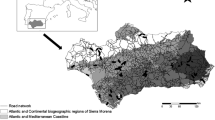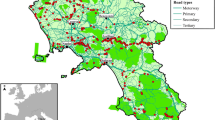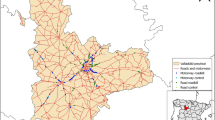Abstract
Roads are one of the most severe threats to wildlife globally because of their pervasive and linear nature. Despite considerable attention afforded to road-effects on animals generally, little information is available concerning the specific impacts of road widening, also known as twinning or highway expansion. To address this gap, we monitored the abundance and distribution of large mammals adjacent to an 18-km section of highway in Ontario, Canada, that underwent expansion from a two-lane to a four-lane, divided highway, over 4 years. We expected to observe an initial decrease in large mammal track abundance and an increased distance from the highway, followed by a period of habituation during which track abundance and proximity to the highway would return to baseline levels. To quantify the effects of highway expansion, we monitored snow-tracks of three ungulates, two felids, and three canids on transects extending perpendicular and parallel to the highway. Our analyses revealed that proximity was species-specific and varied seasonally, but we found little evidence that the new four-lane highway alignment affected the movement ecology of large mammals in our study area. Limited increases in traffic volume could partially explain why we detected no change; however, traffic volume will rise. Although road widening is common for accommodating increased traffic volume, no studies have explicitly investigated its effects on animal movement ecology. Our findings suggest that increasing the footprint of existing roads, rather than building new roads, may be a suitable solution for accommodating increasing traffic with minimal impacts on adjacent large mammal communities.



Similar content being viewed by others
References
Bateman PW, Fleming PA (2012) Big city life: carnivores in urban environments. J Zool 287:1–23. https://doi.org/10.1111/j.1469-7998.2011.00887.x
Baxter-Gilbert JH, Riley JL, Lesbarrères D, Litzgus JD (2015) Mitigating reptile road mortality: fence failures compromise ecopassage effectiveness. PLoS One 10:e0120537
Baxter-Gilbert JH, Riley JL, Boyle SP, Lesbarrères D, Litzgus JD (2017) Turning the threat into a solution: using roadways to survey cryptic species and to identify locations for conservation. Aust J Zool 66:50–56. https://doi.org/10.1071/ZO17047
Benson JF, Patterson BR (2013) Moose (Alces alces) predation by eastern coyotes (Canis latrans) and eastern coyote × eastern wolf (Canis latrans × Canis lycaon) hybrids. Can J Zool 91:837–841. https://doi.org/10.1139/cjz-2013-0160
Benson JF, Patterson BR, Wheeldon TJ (2012) Spatial genetic and morphologic structure of wolves and coyotes in relation to environmental heterogeneity in a Canis hybrid zone. Mol Ecol 21:5934–5954. https://doi.org/10.1111/mec.12045
Benson JF, Mahoney PJ, Patterson BR (2015) Spatiotemporal variation in selection of roads influences mortality risk for canids in an unprotected landscape. Oikos 124:1664–1673
Benson JF, Loveless KM, Rutledge LY, Patterson BR (2017) Ungulate predation and ecological roles of wolves and coyotes in eastern North America. Ecol Appl 27:718–733. https://doi.org/10.1002/eap.1499
Ceballos G, Ehrlich PR, Dirzo R (2017) Biological annihilation via the ongoing sixth mass extinction signaled by vertebrate population losses and declines. Proc Natl Acad Sci 114:E6089–E6096. https://doi.org/10.1073/pnas.1704949114
Ciocheti G, de Assis JC, Ribeiro JW, Ribeiro MC (2017) Highway widening and underpass effects on vertebrate road mortality. Biotropica 49:765–769
Clevenger AP, Chruszcz B, Gunson KE (2001) Highway mitigation fencing reduces wildlife-vehicle collisions. Wildl Soc Bull 29:646–653
Coffin AW (2007) From roadkill to road ecology: a review of the ecological effects of roads. J Transp Geogr 15:396–406
Crins WJ, Gray PA, Uhlig PWC, Wester MC (2009) The ecosystems of Ontario, part 1: ecozones and ecoregions. Ontario Ministry of Natural Resources, Peterborough Ontario, Inventory, Monitoring and Assessment. SIB TER IMA TR-01, pp. 71
Dickie M, Serrouya R, McNay RS, Boutin S (2017) Faster and farther: wolf movement on linear features and implications for hunting behaviour. J Appl Ecol 54:253–263
Ditmer MA, Rettler SJ, Fieberg JR, Iaizzo PA, Laske TG, Noyce KV, Garshelis DL (2018) American black bears perceive the risks of crossing roads. Behav Ecol 29:667–675
Dulac J (2013) Global land transport infrastructure requirements: estimating road and railway infrastructure capacity and costs to 2050. Int Energy Agency, France, p 54
Environment and Climate Change Canada (2019) Historical weather data report (Sudbury A Ontario). http://climate.weather.gc.ca/climate_data/daily_data_e.html. Accessed 20 Sept 2003
Epps CW, Palsbøll PJ, Wehausen JD, Roderick GK, Ramey RR II, McCullough DR (2005) Highways block gene flow and cause a rapid decline in genetic diversity of desert bighorn sheep. Ecol Lett 8:1029–1038
ESRI (2015) ArcGIS Desktop: V 10.2. Environmental Systems Research Institute, Redlands
Forman RTT, Alexander LE (1998) Roads and their major ecological effects. Annu Rev Ecol Syst 29:207–231
Forman RTT, Deblinger RD (2000) The ecological road-effect zone of a Massachusetts (U.S.A.) suburban highway. Conserv Biol 14:36–46
Gagnon JW, Theimer TC, Dodd NL et al (2007) Traffic volume alters elk distribution and highway crossings in Arizona. J Wildl Manag 71:2318–2323. https://doi.org/10.2193/2006-2
Gunson KE (2017) Effectiveness of wildlife mitigation measures for large- to mid-sized animals on Highway 69 and Highway 11 in MTO Northeastern Region, Ontario. Submitted to the Ontario Ministry of Transportation, North Bay, Ontario, Canada
Halfpenny JC (1987) A field guide to mammal tracking in North America, 2nd edn. Johnson Books, Boulder
Halfpenny JC, Thompson RW, Morse SC et al (1997) Snow tracking. In: Mesocarnivores of Northern California: biology, management, & survey techniques. Humbolt State University, Arcata, California, pp 93–101
Hamr J, Mallory FF, Filion I (2016) The history of elk (Cervus canadensis) restoration in Ontario. Can Field-Naturalist 130:167–173
Haskell SP, Ballard WB (2008) Annual re-habituation of calving caribou to oilfields in northern Alaska: implications for expanding development. Can J Zool 86:627–637
Jacobson SL, Bliss-Ketchum LL, De Rivera CE, Smith WP (2016) A behavior-based framework for assessing barrier effects to wildlife from vehicle traffic volume. Ecosphere 7:e01345
Jaeger JAG, Fahrig L (2004) Effects of road fencing on population persistence. Conserv Biol 18:1651–1657
Laurance WF, Clements GR, Sloan S, O’Connell CS, Mueller ND, Goosem M, Venter O, Edwards DP, Phalan B, Balmford A, van der Ree R, Arrea IB (2014) A global strategy for road building. Nature 513:229–232
Laurian C, Dussault C, Ouellet J-P, Courtois R, Poulin M, Breton L (2008) Behavior of moose relative to a road network. J Wildl Manag 72:1550–1557
Leblond M, Dussault C, Ouellet J-P (2013) Avoidance of roads by large herbivores and its relation to disturbance intensity. J Zool 289:32–40
Lesbarreres D, Fahrig L (2012) Measures to reduce population fragmentation by roads: what has worked and how do we know? TREE 27(7): 374–380. https://doi.org/10.1016/j.tree.2012.01.015
Lombardi JV, Comer CE, Scognamillo DG, Conway WC (2017) Coyote, fox, and bobcat response to anthropogenic and natural landscape features in a small urban area. Urban Ecosyst 20:1239–1248. https://doi.org/10.1007/s11252-017-0676-z
Marino A, Johnson A (2012) Behavioural response of free-ranging guanacos (Lama guanicoe) to land-use change: habituation to motorised vehicles in a recently created reserve. Wildl Res 39:503–511
Martin MM (2011) Spatial behaviour and habitat use by elk (Cervus elaphus) in response to highway construction and interprovincial relocation. Thesis, Laurentian University
Mathisen KM, Wójcick A, Borowski Z (2018) Effects of forest roads on oak trees via cervid habitat use and browsing. For Ecol Manag 424:378–386. https://doi.org/10.1016/j.foreco.2018.04.057
McGeachy DNC (2014) Population distribution and seasonal resource selection by elk (Cervus elaphus) in Central Ontario. Thesis, Laurentian University
Mech LD, McRoberts RE, Peterson RO, Page RE (1987) Relationship of deer and moose populations to previous winters’ snow. J Anim Ecol 56:615–627. https://doi.org/10.2307/5072
Montgomery RA, Vucetich JA, Peterson RO, Roloff GJ, Millenbah KF (2013) The influence of winter severity, predation and senescence on moose habitat use. J Anim Ecol 82:301–309. https://doi.org/10.1111/1365-2656.12000
Muhly TB, Johnson CA, Hebblewhite M, Neilson EW, Fortin D, Fryxell JM, Latham ADM, Latham MC, McLoughlin PD, Merrill E, Paquet PC, Patterson BR, Schmiegelow F, Scurrah F, Musiani M (2019) Functional response of wolves to human development across boreal North America. Ecol Evol Accepted 9:10801–10815. https://doi.org/10.1002/ece3.5600
Ontario Ministry of Transportation (2005) Highway 69 action plan
Ontario Ministry of Transportation (2010) Provincial highways annual average daily traffic (AADT). King’s Highways / Secondary Highways / Tertiary Roads. Ministry of Transportation, Highway Standards Branch, Traffic Office. p 57
Ontario Ministry of Transportation (2016) Provincial highways annual average daily traffic (AADT). King’s Highways / Secondary Highways / Tertiary Roads. Ministry of Transportation, Highway Standards Branch, Traffic Office. p 57
Poessel SA, Burdett CL, Boydston EE, Lyren LM, Alonso RS, Fisher RN, Crooks KR (2014) Roads influence movement and home ranges of a fragmentation-sensitive carnivore, the bobcat, in an urban landscape. Biol Conserv 180:224–232. https://doi.org/10.1016/j.biocon.2014.10.010
Popp JN, Boyle SP (2017) Railway ecology: underrepresented in science? Basic Appl Ecol 19:84–93
Popp JN, McGeachy DNC, Hamr J (2013) Elk (Cervus elaphus) seasonal habitat selection in a heterogeneous forest structure. Int J For Res 2013:1–7. https://doi.org/10.1155/2013/415913
Popp JN, Hamr J, Larkin JL, Mallory FF (2018) Black bear (Ursus americanus) and wolf (Canis spp.) summer diet composition and ungulate prey selectivity in Ontario, Canada. Mammal Res 63:433–441. https://doi.org/10.1007/s13364-018-0368-y
Prokopenko CM, Boyce MS, Avgar T (2017) Extent-dependent habitat selection in a migratory large herbivore: road avoidance across scales. Landsc Ecol 32:313–325. https://doi.org/10.1007/s10980-016-0451-1
R Development Core Team (2018) R: a language and environment for statistical computing. R Foundation for Statistical Computing, Vienna, Austria. https://www.R-project.org/
Rhodes JR, Lunney D, Callaghan J, McAlpine CA (2014) A few large roads or many small ones? How to accommodate growth in vehicle numbers to minimise impacts on wildlife. PLoS One 9:e91093. https://doi.org/10.1371/journal.pone.0091093
Rytwinski T, Fahrig L (2013) Why are some animal populations unaffected or positively affected by roads? Oecologia 173:1143–1156
Sawyer H, Korfanta NM, Nielson RM, Monteith KL, Strickland D (2017) Mule deer and energy development-long-term trends of habituation and abundance. Glob Chang Biol 23:4521–4529
Seiler A (2001) Ecological effects of roads: a review. Thesis, Uppsala - Swedish University of Agricultural Sciences, pp. 40
Sokal RR, Rohlf FJ (1995) Biometry: the principles and practice of statistics in biological research, 3rd edn. W.H. Freeman and Company, New York
Squires JR, McKelvey KS, Ruggiero LF (2004) A snow-tracking protocol used to delineate local lynx, Lynx canadensis, distributions. Can Field-Naturalist 118:583–589
Squires JR, Olson LE, Turner DL, DeCesare NJ, Kolbe JA (2012) Estimating detection probability for Canada lynx Lynx canadensis using snow-track surveys in the northern Rocky Mountains, Montana, USA. Wildl Biol 18:215–224. https://doi.org/10.2981/10-105
Taylor BD, Goldingay RL (2014) Use of highway underpasses by bandicoots over a 7-year period that encompassed road widening. Aust Mammal 36:178–183
Teixeira FZ, Rytwinski T, Fahrig L (2020) Inference in road ecology research: what we know versus what we think we know. Biol Lett 16:20200140
Thompson ID, Vukelich MF (1981) Use of logged habitats in winter by moose cows with calves in northeastern Ontario. Can J Zool 59:2103–2114. https://doi.org/10.1139/z81-287
Thurber JM, Peterson RO, Drummer TD, Thomasma SA (1992) Grey wolf responses to refuge boundaries and roads in Alaska. Wildl Soc Bull 22:61–68
Timmermann HR, Rodgers AR (2017) The status and management of moose in North America-circa 2015. Alces 53:1–22
Trombulak SC, Frissell CA (2000) Review of ecological effects of roads on terrestrial and aquatic communities. Conserv Biol 14:18–30
Wattles DW, Zeller KA, DeStefano S (2018) Response of moose to a high density road network. J Wildl Manag 82:929–939
Whittington J, St. Clair CC, Mercer G (2004) Path tortuosity and the permeability of roads and trails to wolf movement. Ecol Soc 9:4
Wilkinson L (2011) ggplot2: elegant graphics for data analysis. Springer-Verlag New York. https://ggplot2.tidyverse.org
Acknowledgements
The authors would like to thank Kari Gunson for her involvement in project design and data collection, and for providing editorial suggestions. Thanks to Jeff Bowman, Joe Hamr, Colleen Cassady St. Clair, and Kimberley Andrews for their feedback on SPB’s dissertation.
Funding
This research was funded through the HIIFP #2011-P-193306 held by DL, and by Laurentian University.
Author information
Authors and Affiliations
Corresponding author
Ethics declarations
Conflict of interest
The authors declare that they have no conflicts of interest.
Additional information
Publisher’s note
Springer Nature remains neutral with regard to jurisdictional claims in published maps and institutional affiliations.
This article is part of the Topical Collection on Road Ecology
Guest Editor: Marcello D’Amico
Rights and permissions
About this article
Cite this article
Boyle, S.P., Litzgus, J.D. & Lesbarrères, D. Limited evidence for negative effects of highway widening on North American large mammals. Eur J Wildl Res 66, 90 (2020). https://doi.org/10.1007/s10344-020-01428-4
Received:
Revised:
Accepted:
Published:
DOI: https://doi.org/10.1007/s10344-020-01428-4




